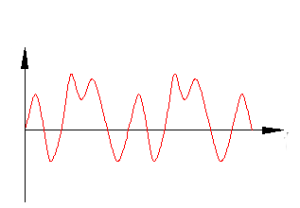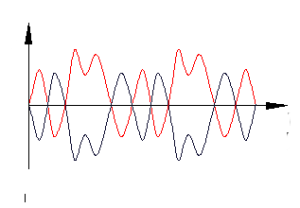The term “balanced” is somewhat ambiguous when it comes to audio. Definitions:
Balanced: means conductors have equal impedance to ground.
Differential: means 2 complementary voltage signals, where complementary means that at every instant in time their voltages are opposites of each other.
Generally speaking, you can have either one without the other. But in audio, they are almost always used together. Thus in the realm of audio, the term “balanced” usually means both differentially signalled and balanced.
Unbalanced Audio
Most audio gear (at least consumer gear) is unbalanced. The musical signal or waveform is a voltage. And a voltage is a potential difference between 2 points – we can’t talk about the voltage at a single point. So the musical signal is carried by 2 wires, + and –. The voltage that represents the musical signal is carried on the + wire, and swings back and forth positive and negative relative to the – wire. The – wire does not carry a signal; its voltage doesn’t change; it is ground.
What exactly do we mean by ground? At least 2 different things! Signal ground is the 0 voltage or “neutral” against which the + wire is compared. Chassis or frame ground is the 0 voltage or “neutral”against which the device power (115 or 230 V) is measured. With standard unbalanced audio, signal and frame ground are the same thing.
The potential problem with standard unbalanced audio is that the – terminal isn’t always an unchanging “zero” or “neutral”. It can pick up a varying voltage. In an ideal system this never happens, but in the real world it does. When this happens, it creates noise because the “music” is the difference between + and –, so any variation on the – terminal changes the musical signal.
How can the – wire pick up a spurious voltage? Imagine a source device (like a CD player) plugged into a different power outlet than the headphone amp. Different power outlets in your house may have slightly different voltage levels on their – terminal, and may have small (a few ohms) of impedance between them. This can cause a small current flow through the ground wire. When that happens, that ground current can appear on the – wire. If that ground current is alternating (for example at 60 Hz, the frequency of our AC power), then this 60 Hz tone (and additional harmonics) is added to the music. We hear “hum”.
Balanced Audio
A balanced system eliminates this problem by adding an extra wire: each channel is carried by 3 wires. Signal +, signal –, and ground. Put differently, balanced separates signal ground from frame ground. In a balanced audio system, the musical signal is the difference between the + and – wires. So, if there is a ground current like above, it travels on the separate ground wire and doesn’t affect the signal.
As the musical signal is the difference between the + and – wire, we have some options how to use the – wire:
- Could be a flat “zero” or “neutral”. The – wire doesn’t carry any signal, but only serves as a neutral reference for the voltage on the + wire, much like unbalanced audio.
- Could carry an inverted mirror image of the + wire. It’s a varying voltage that is the opposite of the + wire at every moment in time.
Most balanced audio systems use option (2) above, which leads to a discussion about differential signalling.
Differential Signalling
Below is a graph of what an standard unbalanced (single ended) audio signal looks like. The Y axis is volts, the X axis is time. The red line is the + wire, the black horizontal line is the – wire. The + wire carries the musical signal, the – wire is ground. This is sometimes called “single-ended” because only one wire carries the musical signal.
Below is what the same audio signal looks like when balanced (signalled differentially). The red line is the + signal, the blue line is the – signal. Here, neither wire carries frame ground. Each wire carries the same signal, but they have reverse polarity (inverted amplitude). The difference between them is a signal having twice the amplitude of either alone. At every instant in time, the voltage sum of the + and – wires is zero, so the overall cable (containing both + and – wires insulated from each other) has a net field of zero, which makes it immune to interference. Put differently, any external electrical field interference affects both wires the same, so it doesn’t change the difference between them.
This gives balanced audio 3 advantages
- S/N ratio is 6 dB higher (twice the voltage = 6 dB)
- Immunity from common interference
- Immunity from grounding issues and loops
Balanced audio was designed for microphones, which have low level signals carried on long wires. In this application, noise isolation is important and you need all the S/N you can get. Consumer audio analog line levels are in the range of 1-2 Volts, about 1,000 times or 60 dB stronger than microphones. And cable runs tend to be shorter.
Thus, balanced audio doesn’t make much difference in most consumer audio applications (if your house is wired properly). It’s a superior engineering design, but it doesn’t necessarily make any audible difference especially in top notch gear that already has S/N ratios over 100 dB. It’s nice to have, but I would not choose one piece of equipment over another, for this feature alone. Sound quality comes first, balanced vs. single ended is a secondary concern. All else equal, balanced is better. But all else is not always equal, and some single ended amps are better than some balanced amps.

